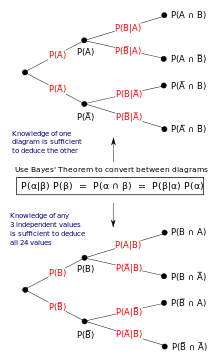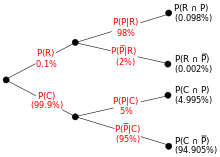Bayes' theorem: Difference between revisions
Curb Chain (talk | contribs) →Further reading: not the same |
→External links: Added a link to a video explaining Bayes' frequentist interpretation |
||
| Line 193: | Line 193: | ||
*[http://www.celiagreen.com/charlesmccreery/statistics/bayestutorial.pdf A tutorial on probability and Bayes’ theorem devised for Oxford University psychology students] |
*[http://www.celiagreen.com/charlesmccreery/statistics/bayestutorial.pdf A tutorial on probability and Bayes’ theorem devised for Oxford University psychology students] |
||
* [http://juanreyero.com/article/math/bayes.html A graphical explanation of the Bayes theorem]. |
* [http://juanreyero.com/article/math/bayes.html A graphical explanation of the Bayes theorem]. |
||
* [http://www.youtube.com/watch?v=D8VZqxcu0I0 Baye's frequentist interpretation explained visually] (video) |
|||
* [https://docs.google.com/document/pub?id=1Qm4HJ4xMMoWfVsKLGCqpUdojyA5qcNII_www45W9Klk Bayes’ rule: A Tutorial Introduction by JV Stone]. |
* [https://docs.google.com/document/pub?id=1Qm4HJ4xMMoWfVsKLGCqpUdojyA5qcNII_www45W9Klk Bayes’ rule: A Tutorial Introduction by JV Stone]. |
||
Revision as of 16:40, 8 November 2012

| Part of a series on |
| Bayesian statistics |
|---|
| Posterior = Likelihood × Prior ÷ Evidence |
| Background |
| Model building |
| Posterior approximation |
| Estimators |
| Evidence approximation |
| Model evaluation |
In probability theory and statistics, Bayes' theorem (alternatively Bayes' law) is a theorem with two distinct interpretations. In the Bayesian interpretation, it expresses how a subjective degree of belief should rationally change to account for evidence. In the frequentist interpretation, it relates inverse representations of the probabilities concerning two events. In the Bayesian interpretation, Bayes' theorem is fundamental to Bayesian statistics, and has applications in fields including science, engineering, economics (particularly microeconomics), game theory, medicine and law. The application of Bayes' theorem to update beliefs is called Bayesian inference.
Bayes' theorem is named for Thomas Bayes (/ˈbeɪz/; 1701–1761), who first suggested using the theorem to update beliefs. His work was significantly edited and updated by Richard Price before it was posthumously read at the Royal Society. The ideas gained limited exposure until they were independently rediscovered and further developed by Laplace, who first published the modern formulation in his 1812 Théorie analytique des probabilités. Until the second half of the 20th century, the Bayesian interpretation was largely rejected by the mathematics community as unscientific[citation needed]. However, it is now widely accepted. This may have been due to the development of computing, which enabled the successful application of Bayesianism to many complex problems.[1]
Introductory example
Suppose someone told you they had a nice conversation with someone on the train. Not knowing anything else about this conversation, the probability that they were speaking to a woman is 50%. Now suppose they also told you that this person had long hair. It is now more likely they were speaking to a woman, since most long-haired people are women. Bayes' theorem can be used to calculate the probability that the person is a woman.
To see how this is done, let
- represent the event that the conversation was held with a woman, and
- denote the event that the conversation was held with a long-haired person.
It can be assumed that women constitute half the population for this example. So, not knowing anything else, the probability that occurs is
Suppose it is also known that 75% of women have long hair, which we denote as
(read: the probability of event given event is 0.75).
Likewise, suppose it is known that 30% of men have long hair, or
- ,
where is the complementary event of , i.e., the event that the conversation was held with a man (assuming that every human is either a man or a woman).
Our goal is to calculate the probability that the conversation was held with a woman, given the fact that the person had long hair, or, in our notation, . Using the formula for Bayes' theorem, we have:
where we have used the law of total probability. The numeric answer can be obtained by substituting the above values into this formula. This yields
i.e., the probability that the conversation was held with a woman, given that the person had long hair, is about 71%.
Statement and interpretation
Mathematically, Bayes' theorem gives the relationship between the probabilities of and , and , and the conditional probabilities of given and given , and . In its most common form, it is:
The meaning of this statement depends on the interpretation of probability ascribed to the terms:
Bayesian interpretation
In the Bayesian (or epistemological) interpretation, probability measures a degree of belief. Bayes' theorem then links the degree of belief in a proposition before and after accounting for evidence. For example, suppose somebody proposes that a biased coin is twice as likely to land heads than tails. Degree of belief in this might initially be 50%. The coin is then flipped a number of times to collect evidence. Belief may rise to 70% if the evidence supports the proposition.
For proposition and evidence ,
- , the prior, is the initial degree of belief in .
- , the posterior, is the degree of belief having accounted for .
- represents the support provides for .
For more on the application of Bayes' theorem under the Bayesian interpretation of probability, see Bayesian inference.
Frequentist interpretation

In the frequentist interpretation, probability measures a proportion of outcomes. For example, suppose an experiment is performed many times. is the proportion of outcomes with property , and that with property . is the proportion with out of those with , and the proportion of those with out of those with .
The role of Bayes' theorem is best visualized with tree diagrams, as shown to the right. The two diagrams partition the same outcomes by and in opposite orders, to obtain the inverse probabilities. Bayes' theorem serves as the link between these different partitionings.
Forms
Events
Simple form
For events and , provided that
In a Bayesian inference step, the probability of evidence is constant for all models . The posterior may then be expressed as proportional to the numerator:
Extended form
Often, for some partition of the event space, the event space is given or conceptualized in terms of and . It is then useful to eliminate using the law of total probability:
In the special case of a binary partition,
Random variables

Consider a sample space generated by two random variables and . In principle, Bayes' theorem applies to the events and . However, terms become 0 at points where either variable has finite probability density. To remain useful, Bayes' theorem may be formulated in terms of the relevant densities (see Derivation).
Simple form
If is continuous and is discrete,
If is discrete and is continuous,
If both and are continuous,
Extended form

A continuous event space is often conceptualized in terms of the numerator terms. It is then useful to eliminate the denominator using the law of total probability. For , this becomes an integral:
Bayes' rule
Under the Bayesian interpretation of probability, Bayes' rule may be thought of as Bayes' theorem in odds form.
where
So the rule says that the posterior odds are the prior odds times the Bayes factor.
Derivation
For events
Bayes' theorem may be derived from the definition of conditional probability:
For random variables
For two continuous random variables and , Bayes' theorem may be analogously derived from the definition of conditional density:
Examples
Frequentist example

An entomologist spots what might be a rare subspecies of beetle, due to the pattern on its back. In the rare subspecies, 98% have the pattern. In the common subspecies, 5% have the pattern. The rare subspecies accounts for only 0.1% of the population. How likely is the beetle to be rare?
From the extended form of Bayes' theorem,
Drug testing

Suppose a drug test is 99% sensitive and 99% specific. That is, the test will produce 99% true positive results for drug users and 99% true negative results for non-drug users. Suppose that 0.5% of people are users of the drug. If a randomly selected individual tests positive, what is the probability he or she is a user?
Despite the apparent accuracy of the test, if an individual tests positive, it is more likely that they do not use the drug than that they do.
This surprising result arises because the number of non-users is very large compared to the number of users, such that the number of false positives (0.995%) outweighs the number of true positives (0.495%). To use concrete numbers, if 1000 individuals are tested, there are expected to be 995 non-users and 5 users. From the 995 non-users, false positives are expected. From the 5 users, true positives are expected. Out of 15 positive results, only 5, about 33%, are genuine.
History
Bayes' theorem was named after the Reverend Thomas Bayes (1701–61), who studied how to compute a distribution for the probability parameter of a binomial distribution (in modern terminology). His friend Richard Price edited and presented this work in 1763, after Bayes' death, as An Essay towards solving a Problem in the Doctrine of Chances.[2] The French mathematician Pierre-Simon Laplace reproduced and extended Bayes' results in 1774, apparently quite unaware of Bayes' work.[3] Stephen Stigler suggested in 1983 that Bayes' theorem was discovered by Nicholas Saunderson some time before Bayes.[4] However, this interpretation has been disputed.[5]
Stephen Fienberg describes the evolution from "inverse probability" at the time of Bayes and Laplace, a term still used by Harold Jeffreys (1939), to "Bayesian" in the 1950s.[6] Ironically, Ronald A. Fisher introduced the "Bayesian" label in a derogatory sense[citation needed].
Notes
- ^ McGrayne, Sharon Bertsch. (2011). The Theory That Would Not Die: How Bayes' Rule Cracked The Enigma Code, Hunted Down Russian Submarines, & Emerged Triumphant from Two Centuries of Controversy. New Haven: Yale University Press. 13-ISBN 9780300169690/10-ISBN 0300169698; OCLC 670481486 The Theory That Would Not Die, p. 10., p. 10, at Google Books
- ^
Bayes, Thomas, and Price, Richard (1763). "An Essay towards solving a Problem in the Doctrine of Chance. By the late Rev. Mr. Bayes, communicated by Mr. Price, in a letter to John Canton, M. A. and F. R. S." (PDF). Philosophical Transactions of the Royal Society of London. 53 (0): 370–418. doi:10.1098/rstl.1763.0053.
{{cite journal}}: CS1 maint: multiple names: authors list (link) - ^ Daston, Lorraine (1988). Classical Probability in the Enlightenment. Princeton Univ Press. p. 268. ISBN 0-691-08497-1.
- ^ Stigler, Stephen M. (1983), "Who Discovered Bayes' Theorem?" The American Statistician 37(4):290–296.
- ^ Edwards, A. W. F. (1986), "Is the Reference in Hartley (1749) to Bayesian Inference?", The American Statistician 40(2):109–110
- ^ Fienberg, Stephen E. (2006).When Did Bayesian Inference Become “Bayesian”?.
Further reading
- Pierre-Simon Laplace. (1774/1986), "Memoir on the Probability of the Causes of Events", Statistical Science 1(3):364–378.
- Stephen M. Stigler (1986), "Laplace's 1774 Memoir on Inverse Probability", Statistical Science 1(3):359–363.
External links
- Earliest Known Uses of Some of the Words of Mathematics (B). Contains origins of "Bayesian", "Bayes' Theorem", "Bayes Estimate/Risk/Solution", "Empirical Bayes", and "Bayes Factor".
- Bayesian Statistics summary from Scholarpedia.
- Weisstein, Eric W. "Bayes' Theorem". MathWorld.
- Bayes' theorem at PlanetMath.
- A tutorial on probability and Bayes’ theorem devised for Oxford University psychology students
- A graphical explanation of the Bayes theorem.
- Baye's frequentist interpretation explained visually (video)
- Bayes’ rule: A Tutorial Introduction by JV Stone.
















































![{\displaystyle {\begin{aligned}P({\text{Rare}}|{\text{Pattern}})&={\frac {P({\text{Pattern}}|{\text{Rare}})P({\text{Rare}})}{P({\text{Pattern}}|{\text{Rare}})P({\text{Rare}})\,+\,P({\text{Pattern}}|{\text{Common}})P({\text{Common}})}}\\[8pt]&={\frac {0.98\times 0.001}{0.98\times 0.001+0.05\times 0.999}}\\[8pt]&\approx 1.9\%.\end{aligned}}}](https://wikimedia.org/api/rest_v1/media/math/render/svg/df14f22e3069abe228fceef552a21449a73f13f8)
![{\displaystyle {\begin{aligned}P({\text{User}}|{\text{+}})&={\frac {P({\text{+}}|{\text{User}})P({\text{User}})}{P({\text{+}}|{\text{User}})P({\text{User}})+P({\text{+}}|{\text{Non-user}})P({\text{Non-user}})}}\\[8pt]&={\frac {0.99\times 0.005}{0.99\times 0.005+0.01\times 0.995}}\\[8pt]&\approx 33.2\%\end{aligned}}}](https://wikimedia.org/api/rest_v1/media/math/render/svg/b6758dfd0e80f5b3417705c81d079939acc925be)

